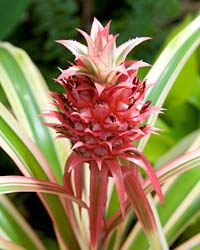Ananus comosus
 Tropical plants, with their dramatic foliage, oversized flowers, and sensational color schemes, can add an exciting dimension to summer gardens. In winter, many of these same tropicals reappear, this time contributing a stylish twist to indoor gardens. One plant able to make a stunning statement indoors or out is a symbol of holiday hospitality: the pineapple plant, Ananas comosus.
Tropical plants, with their dramatic foliage, oversized flowers, and sensational color schemes, can add an exciting dimension to summer gardens. In winter, many of these same tropicals reappear, this time contributing a stylish twist to indoor gardens. One plant able to make a stunning statement indoors or out is a symbol of holiday hospitality: the pineapple plant, Ananas comosus.
Native to South America, the pineapple plant was cultivated by local people for hundreds of years before colonialism and the age of exploration transported it to China, the Phillipines, Java, and eventually Hawaii, where it became synonymous with the islands' image. The Victorians, in their zeal for collecting exotic plants, grew pineapple "under glass," furthering its reputation as a houseplant. These glass hothouses succeeded with the help of steam boilers, which raised the temperature and humidity to the high levels necessary for good growth.
Ananas is a member of the bromeliad family, a diverse group of more than 2,000 plants, most of which are tropical ephiphytes — plants that anchor themselves to tree branches but whose roots never touch soil. Animal and bird droppings, along with fallen leaves, comprise the plant’s food, and rain water is captured by the plant’s vase-shaped leaves and central cup or cone. The arching spray of jagged leaves surrounds a rosette from which a squat, central flower stalk emerges, followed by lavender-blue flowers and, eventually, the pineapple fruit. The cycle of flower stalk to flowers to fruit often takes several months.
The cultivated pineapple plant is not grown as a treetop plant, however, but in extremely well-drained soil. Pineapple plants for the home, available either locally or through tropical mail-order nurseries, are usually less than 2 feet tall and quite showy, some with variegated foliage in tones of olive with yellow and pink streaks. The fruit is equally dwarf, no taller than 4 inches.
Pineapple plants require warm conditions (70 to 90 degrees with a 10-degree drop at night); high humidity; and porous, fast-draining soil such as a soilless or sand-based mix. Apply a general houseplant fertilizer every two months, until flowering begins, and then increase it to every other week. Keep the pineapple plant in its own separate pot, even when grouping it with companion plants, to keep its roots away from any soggy soil that may result from overwatering.

